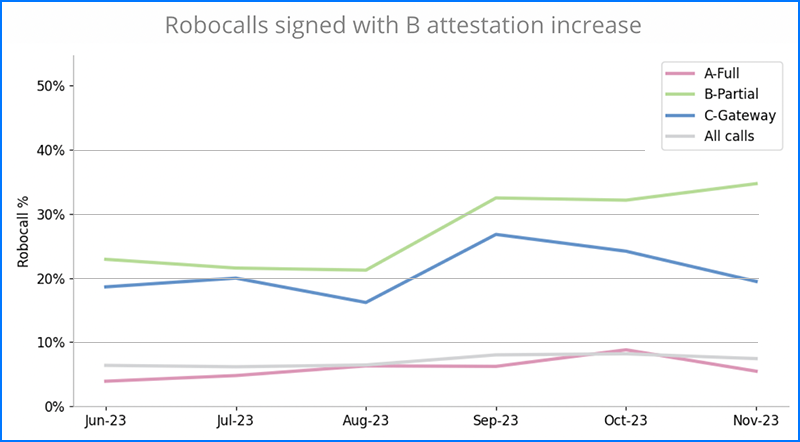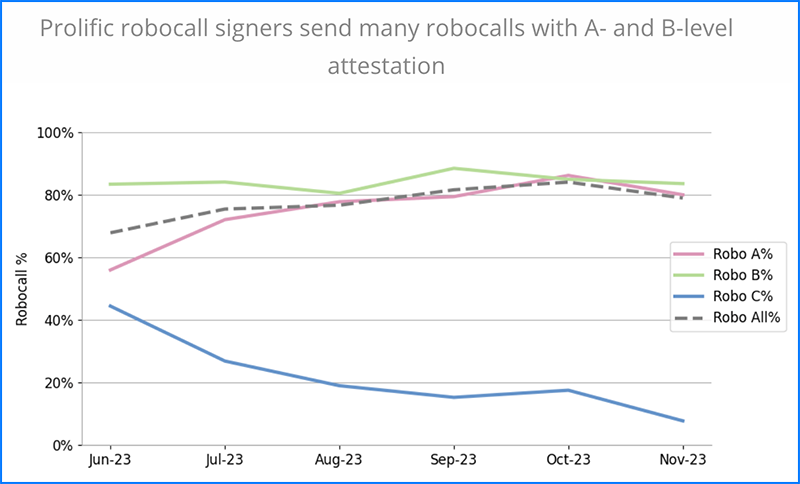The Latest Telecom Stats
Key Terms:
CSP: Communications service provider
STIR: “Secure Telephone Identity Revisited” protocol
SHAKEN: “Signature-based Handling of Asserted information using toKENs” framework
Call attestation: CSPs assign an attestation level to calls originating on their network based on how well they know the caller and the phone number being used:
“A” – The CSP knows the caller and the number
“B” – The knows the caller but not the source of the number
“C” – The call originated from an unknown source
* * * * *
Everyone who’s ever owned a phone knows about the scourge of illegal robocalls; most of us have simply stopped answering any number we can’t identify (and yes, perhaps, curse). The FCC is committed to restoring the faith of consumers by reducing or even eliminating these calls, including the enactment of its STIR/SHAKEN legislation a couple of years ago to help track down where these calls are coming from.
Hopefully, most VoIP customers now have a basic understanding of this legislation and its call attestation requirements, and legitimate callers have worked to earn an “A” attestation level from their CSP.
TransNexus, a leading provider of telecommunications software for protecting and managing networks, offers monthly statistics on the current state of robocalling and their levels of attestation based on STIR/SHAKEN participation, as well as the trends across the past six months. Is STIR/SHAKEN making a difference? Are robocalls increasing or decreasing, and how are they being signed? Are providers assigning accurate attestation?
We found some of the data very interesting.
Since all CSPs are supposed to attest at this point, it’s not a big surprise that the number of authorized CSPs participating in STIR/SHAKEN is now increasing only nominally (0.6%) each month, and TransNexus customers observed a 2.8% increase in signers.
The number of signed calls at termination has remained steady at 31 to 32%. While this might seem relatively low, TransNexus believes “the primary reason for low STIR/SHAKEN coverage is widespread non-IP interconnections across the telephone network”—in which case we’d expect this result until the vast majority of calls are VoIP.
While the percentage of calls with a “B” attestation has held relatively steady at 3 to 4% of all calls and those with a “C” have dipped just slightly (also accounting for 3 to 4% of calls), calls with a full “A” attestation have dropped from a 24.5% high in July down to 21.2%—a 13.5% drop. While TransNexus doesn’t comment on this, is it possible that some CSPs are more reticent to assign an A as they’ve become increasingly knowledgeable about the ramifications?
Trends in Signing Robocalls
The good news is that, overall, robocalls continue to decline.
The percentage of robocalls that are signed remains consistent at 7 to 8%. (The gray line below; as a reminder, not all robocalls are illegal.) This means more than 90% are unsigned and, we’re guessing, less likely to be legit.

Signed Robocalls by Attestation, Last Six Months (TransNexus)
Interestingly, however, while the robocalls signed with an “A” or a “C” have dropped, those that are signed with a “B” have increased substantially over the past several months as shown above—essentially making up the difference in the drop of the first two.
Even more interesting, when TransNexus breaks out the top ten authorized providers signing calls identified as robocalls, the vast majority of these calls receive an “A” or “B” attestation—for example, 80% of the CSPs’ signed calls have been identified as robocalls, as shown on the chart below. To reiterate, this means the CSPs are saying they know the caller and, in many cases, can attest to the source of the numbers they use.

Robocall Percentage by Attestation—Prolific Robocall Signers by Robocall % (TransNexus)
TransNexus states, “We believe that terminating providers should evaluate the reputation of STIR/SHAKEN signers and use it as an input to call validation treatment.” This is starting to be factored into the algorithms of the companies used by the top three carriers, as we discussed in our previous article “Phone Call Compliance.” It’s also possible that at least some of those robocalls are legitimate.
The Current Status of Robocalling
Overall, it’s great that many CSPs are participating in STIR/SHAKEN, calls are being signed, and robocalls have nominally fallen. It also seems likely that some of the providers are trying to game the system by signing illegitimate calls—although they might get caught in the algorithms.
STIR/SHAKEN has made a difference in illegal robocalling, but it’s just the first step and there is still some distance left to go. That said, it’s becoming increasingly clear that who you choose as a provider and their reputation will help determine if your calls go through.















